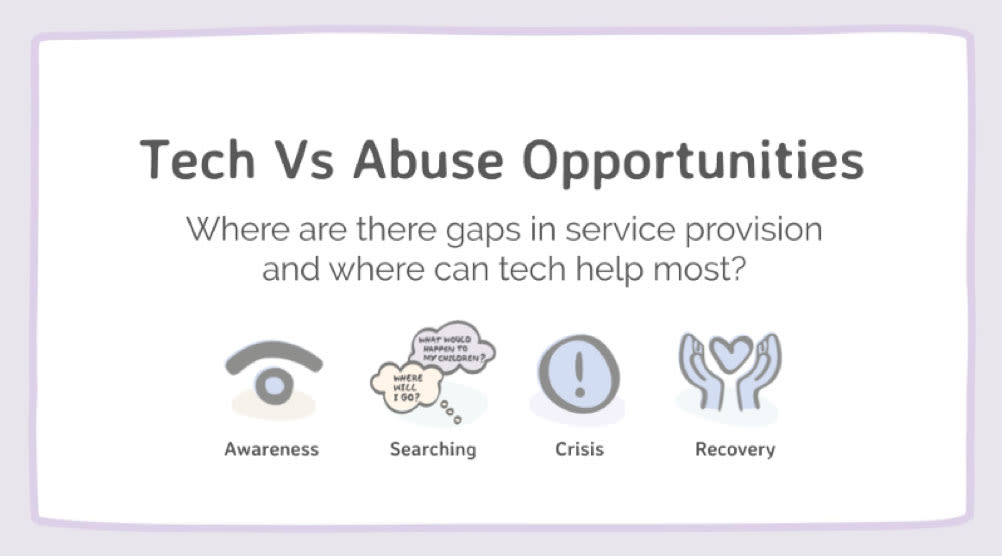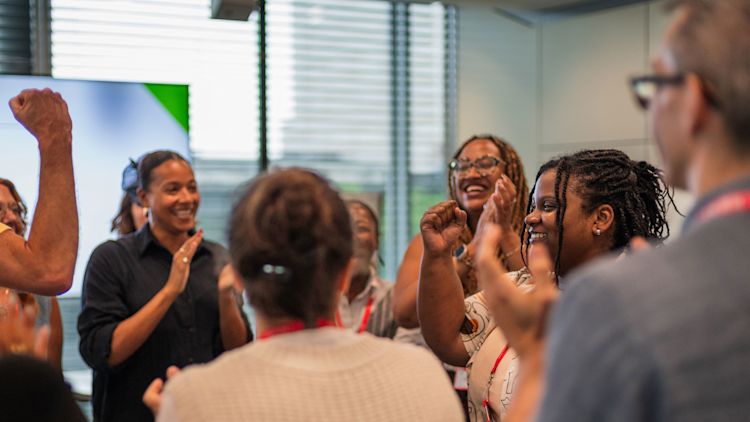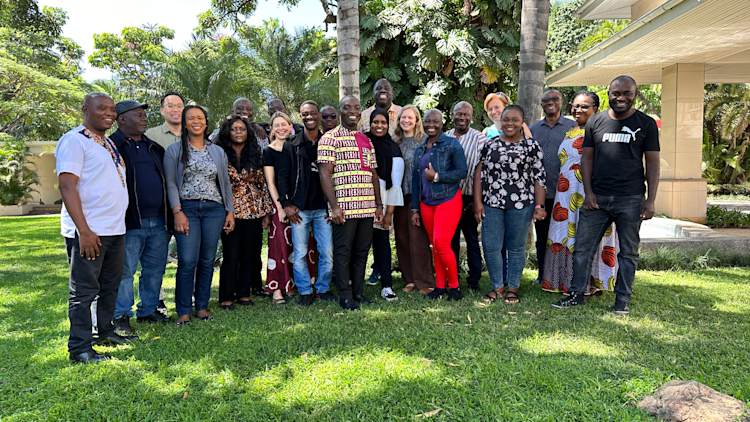
By Nissa Ramsey
Nissa is the founder of Think Social Tech, a research consultancy in the UK not-for-profit sector that delivers projects, provides practical and research support and supports organisations with learning. She also previously worked at Comic Relief.
This post was originally published by Nissa on Medium(opens in new window) under the title ‘Reflections: Tech vs Abuse Fund Design’
Responding to the priorities, needs and opportunities for digital in the domestic abuse sector Comic Relief, with Esmée Fairbairn Foundation and The Clothworkers Foundation have recently re-launched the UK Tech vs Abuse fund, which is open for applications until 12 noon BST on 4 July 2019.
The design of this fund is based on the research and co-design work delivered alongside Snook and SafeLives and with close involvement of the funders, in May and June 2019. The aims and intent of this are explained in my earlier post. We interviewed practitioners and co-designed this fund with 20 organisations in the domestic and sexual abuse sector developing and delivering digital services, alongside the other funders. You can now find the research report and design challenges report, updated market scan online at techvsabuse.info(opens in new window), alongside the original 2016–17 research.
Here, I want to share more about the decisions and changes that were made in response to the research, in collaboration between the research team and funders (and with iterative feedback from research participants).
Ten decisions we made about the fund and why
We kept the Design Challenges as a framework, but they are broad top-line priorities, not discrete funding streams. Overall, this research found that organisations were very supportive of the original Tech vs Abuse Design Challenges and their continuing relevance. We learnt that they valued understanding the fund priorities. However, they didn’t want to be led by them. Previously organisations had to apply to a specific Design Challenge. Now, the fund will support ideas which directly address, overlap, link to, or cut across the design challenges. It encourages organisations to prioritise their own users’ needs (whether these users are victims, survivors, professionals, perpetrators or other organisations).
The Design Challenges aren’t radically different Overall research participants felt that the experiences of victims, survivors and practitioners using technology and going online, remain largely unchanged to that in 2016. The market scan did uncover many more digital tools, information, services, and resources online compared to 2016. However, research participants felt that the provision of digital services in the UK remains patchy and fragmented, particularly those connecting people to in-person support. They felt that better digital services were still needed, particularly to realise its abuse, find information and to connect to real time services. For this reason, we kept the Design Challenges largely similar, keeping those of realising it’s abuse, finding the right information at the right time (previously fifteen minute window) and effective real time information and support.
We adopted a more inclusive definition of abuse We adopted the government definition of domestic abuse (SafeLives describe this well) because it recognises that abuse can take place in any relationship, regardless of gender or sexuality. It also recognises that abuse can take many forms, including coercive control, and psychological, physical, sexual, financial, and emotional abuse.
We included a new focus on recovery and rebuilding lives. Compared to 2016, there is now a greater recognition of the need to extend support and services beyond the crisis and leaving point, to support those recovering from abuse. Survivors of abuse face many difficulties in rebuilding their lives — ranging from housing and financial to overcoming trauma and avoiding re-victimisation — but support services often end after crisis point due to limitations in funding and resources. We also wanted to better acknowledge that people’s experiences of abuse and their journeys are complex. Some people may not realise they experienced abuse until years after leaving a relationship or they may choose not to leave despite realising they are experiencing abuse. Mental health, sexual abuse organisations or women’s centres therefore may be well placed to develop digital services responding to their specific needs, particularly when working in partnership.
We choose not to keep the Safer Digital Footprint or Legal and Financial Information Design Challenges. The research discovered that the need to secure evidence of abuse and hold information safely, and the needs for more information about how to stay safe online and safeguard against Tech Abuse, are now being addressed by a number of organisations in the UK. There have also been broader developments in online safety education and awareness-raising campaigns, such as 5Rights, Facebook’s Digital Literacy Library and Safer Internet Day. This led us to decide that the 2016 Design Challenge of ‘Safer Digital Footprint’ was being covered more generally. Whilst there is a need for more training, capacity building and awareness of Tech Abuse particularly, this does not lend itself to digital innovation. Accessing legal and financial information was also recognised as a crucial element at all stages of the journey or experience of abuse. We felt it could be addressed as a part of each of the challenge areas, particularly surrounding the provision of information and support.
The fund is open to organisations looking to create digital services for perpetrators, as well as professionals or others supporting someone affected by abuse. Since 2016 there has been increasing recognition of the need to consider supporting perpetrators of abuse, in order to keep those experiencing abuse safer as well as to help perpetrators recognise the need to change their behaviour. Online tools and anonymous support could offer an invaluable support approach. This research also identified an opportunity to enable friends, family, professionals and co-workers to better identify and support those in an abusive relationship. To this end, the fund clearly signposts it is open to a range of end users.
Funding is now for ‘discovery stage’ (you don’t need a prototype) The research found that practitioners most needed digital specific funding to help them prioritise what to develop, to scope what already exists, collaborate with sector partners, and find the right digital partner. In other words, they were seeking flexible funding for discovery and alpha stages of development, including user research, market analysis and prototype development. Previously, the fund was open to all stages of development. In this round, the funding is dedicated to digital products and services at early idea and concept stages of development. It is also open to early stage prototypes that are early stage and need significant redevelopment, acknowledging the need for rigorous user research.
No digital partner needed (but it’s OK to have one and that digital partner might be for service design or user research) The fund includes a three-month discovery stage to develop an idea further and undertake user research, before development and delivery work commences in full over the remaining nine months to develop a solution. This includes scope to explore what solutions already exists (and whether a new solution is needed), collaborate with sector partners and to find the right digital partner throughout the duration of the funding. Previously, the fund was open to all stages of development and gave support as part of the application process to find a digital partner. However, the research found that this remains a significant barrier to those developing projects and it could result in partnerships that are not best placed to deliver the work.
Prioritising collaboration. The participants in this research strongly emphasised the need for more collaboration in the domestic and sexual abuse sector. They felt this partnership work needed to be incentivised, particularly given the different nature of expertise and reach that different types of organisations could bring. Now the fund actively encourages cross-sector partnerships and collaborative proposals, particularly those with specialist organisations taking a lead role, or those which address sector barriers that prevent the delivery of effective services. welcome proposals from the women and girls sector and beyond, including unusual collaborations, such as those working together to develop new solutions alongside design or digital agencies.
Private video applications to help make better funding decisions. This was by far the hardest decision we had to make. Research participants told us that they ‘eye roll’ at best in response to video applications and at worst, it causes them significant resources and worry to prepare. For some, this was an issue of low tech capacity. For others, there were risks in showcasing the work and putting people on camera who have experienced abuse. It is not an approach that comes naturally to very private work. However, the issues were more about reassurance, privacy and understanding the value of video applications to the funders. The participants with experience of creating video applications also felt it provided a good opportunity to bring their team together. For the research team, the funders also demonstrated how videos enable them to make better funding decisions than written applications, with examples of how it enabled them to better understand the project and grasp of the nature of the work, and what the solution proposed might look like or do. They could better share applications, remember them and discuss them. So we decided to keep them. There is detailed guidance, the video is private and is flexible in format and length. We also gave ourselves the challenge of making a video about video applications, in 2 hours — you can watch it here: https://youtu.be/qziq3euXb8U(opens in new window)
Summary
It’s been a privilege and fascinating to see what has changed since 2016. The original needs still exist, both for the provision of digital services and funding tailored to support these services to be researched, designed and developed effectively. Yet we have seen is a greater appetite for and understanding about where digital could add most value to those experiencing abuse.
Overall, practitioners identified ten key challenges for developing digital services. These included: Accessing flexible early stage funding; finding the right digital partner; knowing what it should cost; collaborating with other organisations in the sector; knowing what else exists; safeguarding against discovery by perpetrators (including sensitive marketing); building trust in the safety of the solution; embedding tech skills in the organisation; sharing learning from user research and development; open sourcing solutions. The funding partners were incredibly engaged in the research process, findings and recommendations. We brainstormed at length about how to design the fund to ensure it was open and inclusive, with clear priorities to attract good quality applications without a high rejection rate. We hope the changes to the design of the fund goes some way towards supporting this development.
The funding
Please do share the funding opportunity widely. It’s relevant to domestic abuse and sexual abuse specific organisations, as well as those from any other area of work specifically supporting those affected by abuse (such as those providing support for young people, mental health, debt advice or Women’s Centres). It is also purposefully broad and flexible to allow organisations to work on the priority needs for their users. If you have any questions about the fund you can sign up to the Slack team here or contact Comic Relief on grantsinfo@comicrelief.com
I’m continuing to support the funders to translate and incorporate the research findings and design recommendations in to their decision making processes. I’ll share more about the learning about the applications and process in due course. I’m still nervous that fund will not attract many applications, not least because I know how difficult it is for organisations to prioritise something unknown like this. The feedback from previous grantees has been incredible to hear, both about the challenges but also how much they have learnt, particularly with the intensive support from CAST.
Good luck to all those taking the bold move to apply and I look forward to learning more about your ideas.
The Tech vs Abuse funding call deadline is 4 July 2019, 12 noon BST


